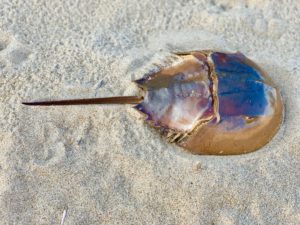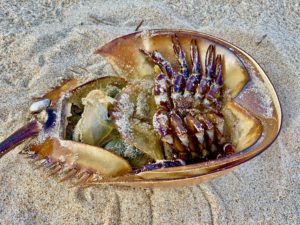
By Mary Reid Barrow
Is that a shell of a horseshoe crab or a dead horseshoe crab that I see washed up on the beach? I used to ask myself.
I knew that horseshoe crabs regularly molted offshore and their shells washed in all the time in late summer. I also knew that dead horseshoe crabs rarely made it to the beach.
Yet, it was years before I knew how to really tell the difference.
That was when Anna English, who grew up walking our ocean beach, showed me to use my fingernail to find the split along the seam between the top and bottom of the horseshoe crab’s shell. A split proved for sure the shell was a discard.
The shells split apart enough for the crab to walk out and then close again, leaving a life-like form behind. If you look at the bottom of the shell, you can see the realistic legs, mouth and even gills that also are left behind. Squeeze one of the little legs and you can feel that there’s not a bit of flesh inside.

Baby horseshoe crabs molt regularly the first year. Adults molt about once year. A full grown female can be up to 2 feet long.
Certain beaches, farther north, especially, are favorite horseshoe crab spawning grounds where females with males in tow come ashore to the intertidal zone. There, they lay their eggs that are then fertilized by the males.
If you happen, by chance, to come across a live or a real dead horseshoe crab, it is apt to be a younger one, because they spend their time closer inshore.
Adults spend their days lumbering across the ocean bottom , like army tanks, looking for worms and little mollusks. They dine with a round mouth located oddly between their legs!
Such an extraordinary mouth placement is not the only unusual thing about a horseshoe crab. It has 10 eyes, three of which are obvious bumps on the top of the shell.
It has a long spikey tail, which looks wicked, but is not a weapon. The horseshoe crab uses its tail more like a marine walking stick to right itself when it is lying on its back.
Though they don’t like being upside down, the critters actually swim upside down when they swim at all.
All those peculiar traits and there is one more… The horseshoe crab’s blue blood (yes, blue) contains a substance that can be used to test injectable drugs and vaccines for bacterial contamination! The blood is actually drawn from live crabs that are then released. Horseshoe crab blood has been in the news recently because it’s played a role in testing the new Covid vaccines.
More akin to spiders than crabs, the horseshoe crab actually dates back to the days of the dinosaur. Who’d ever think that such an ancient odd creature could also be a boon to modern medicine?
Do you have a favorite tree or plant with a story to tell? What relationships have you observed between plants and critters? Who eats whom? Who has babies where? Send an email to maryreid@lrnow.org